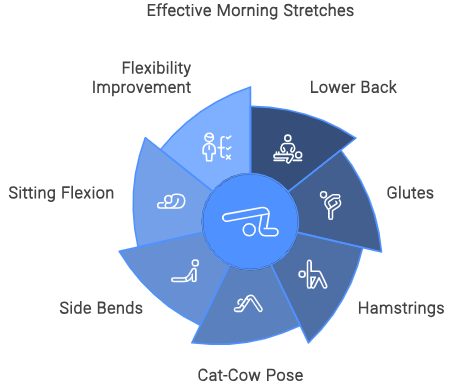Best Morning Stretches to Prevent Back Injuries
Sure, we’ve all rolled out of bed, felt that tightness in our back, and wished we hadn’t. As simple as stretching sounds, it makes a huge difference in keeping back injuries at bay. Over the past 15+ years, we’ve seen countless patients improve their mobility and reduce pain just by adding a few stretches to their morning routine. Focusing on the low back, glutes, and hamstrings, not only prevents injuries but also boosts overall movement and well-being.
Top Morning Stretches for Prevention
Focusing on areas that build up tension the quickest is key to effective stretching. Here are a few general and simple stretches you can add to your morning routine to help relieve muscle tension in areas like the lower back, pelvis, and hamstrings. These stretches can help improve your spine’s flexibility and reduce stiffness. It’s about making these stretches a part of your routine to get your muscles loose and ready for the day.
Here are a few simple and effective stretches to start your day:
- Cat-cow pose: Enhances spinal flexibility and strengthens supporting muscles.
- Side bends: Improves lateral flexibility and stretches intercostal muscles.
- Sitting flexion: Beneficial for alleviating lower back tension.
- Knee-to-chest stretches: Also help to relieve low back tension.
- Pelvic tilts: Strengthens core and stabilizes spine.
Performing these simple stretches consistently will help to reduce muscle tension, improve flexibility, and improve overall spinal health. This particular group of stretches focuses on flexibility in the hips and outer thighs. Muscles of the hips and thighs attach to the pelvis, keeping these muscles loose with regular stretching can reduce the risk of back pain and injury. Talk with your practitioner to get the series of specific stretches that would work best for you.
Benefits of Daily Back Stretching
Regular back stretches can significantly improve your spinal health and overall well-being. Here are the key benefits:
- Reduced muscle tension and stress
- Improved spine mobility and range of motion
- Enhanced overall flexibility and balance
- Decreased risk of back pain and injuries
- Increased blood flow to muscles
While stretching is generally safe, consult one of our healthcare professionals before starting a new routine if you have existing back issues, recent injuries, or chronic conditions. Your therapist can also help identify the stretches that would be most effective in helping with your particular type of back pain.
Chiropractors Tips for a Safe Morning Stretches
Stretching in the morning is great but here are a few simple guidelines to prevent injury:
- Begin with gentle stretches, such as cat-cow or knee-to-chest and gradually progress to more intensive stretches.
- Focus on proper form to maximize benefits and minimize injury risk
- Maintain consistency in your routine
- Listen to your body and avoid pushing through pain.
Frequently Asked Questions
What Are the Best Stretches for Your Back in the Morning?
Good stretches for your back include gentle movements like the cat-cow for flexibility, knee-to-chest to relieve lower back tension, and pelvic tilts to strengthen your core and stabilize your spine. These are generic simple stretches that provide a good starting point for your stretching, as you advance and need more, be sure to contact us for guidance on what is most appropriate for your particular condition.
How can I progress my stretching routine over time?
Start with 5-10 minutes of gentle stretching daily. As you become more comfortable, gradually increase the duration to 15-20 minutes. You can also progress by:
- Holding stretches for longer periods
- Increasing the number of repetitions
- Adding more challenging variations of each stretch
- Incorporating additional stretches that target complementary muscle groups
Are there specific stretches for different types of back pain?
Yes, different stretches can target various types of back pain:
- For lower back pain: Focus on pelvic tilts and knee-to-chest stretches
- For upper back pain: Incorporate shoulder blade squeezes and seated spinal twists
- For sciatica: Try the pigeon pose or seated figure-four stretch
Always consult a healthcare professional for personalized advice, especially if you have chronic or severe pain.
Is It Good to Stretch First Thing in the Morning?
Yes, morning stretching is highly beneficial. However, it’s important to start slow and easy in the morning. The goal is to help wake up your body, improve blood circulation, and prepare your muscles and joints for your daily activities. Think of it as a necessary warm-up for the day ahead.








